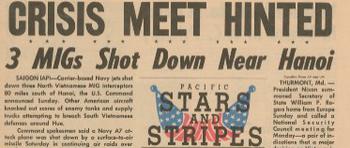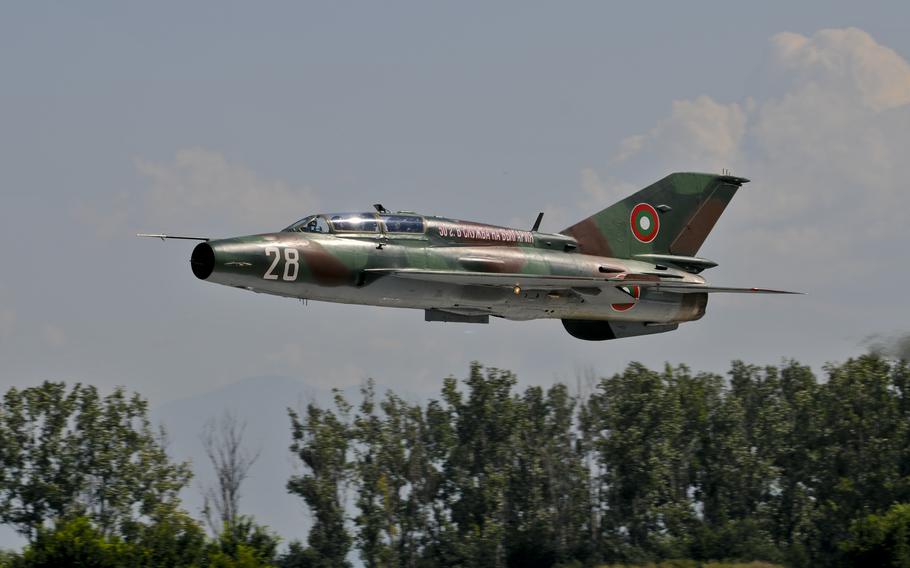
Glass beads cover a Soviet-era fighter at “The MiG-21 Project,” on view through Jan. 26, 2026 at the Museum of Flight in Seattle. (Museum of Flight)
SEATTLE — A steel gray fuselage with a bright red star painted on the side tail was about as ornate as the Soviets got when painting their MiG-21 fighter jets.
But in Seattle, a surplus variant of the jet that NATO dubbed the “Fishbed” has been covered in millions of brilliantly colored glass beads woven by hand for five years to give the old cold warrior a warmly psychedelic look for an offbeat military showcase.
“The MiG-21 Project” opened June 21 at the Museum of Flight, the nation’s largest private collection of military and commercial aircraft. The museum was built around the 1910 “Red Barn” that served as the workshop for the fledgling Boeing aircraft company.
South African artist Ralph Ziman created “The MiG-21 Project” as the last installment of his 12-year trilogy “Weapons of Mass Production.”
Ziman and his workshop staff in Los Angeles previously turned out a bejeweled AK-47 Soviet-era assault rifle and a color-drenched South African Casspir armed vehicle used to enforce racial segregation during the 1980s in the final years of the country’s racial apartheid.
“The aim of ‘The MiG-21 Project’ is to take the most mass-produced supersonic fighter aircraft and to turn it from a machine of war into something that looks beautiful and changes the meaning of it,” Ziman said in a statement launching the exhibition.
The temporary exhibit running through Jan. 26 includes the technicolor-slathered fighter on display and can also be visited in a virtual tour on the museum’s website. The beadwork is the visual centerpiece, but the museum packs the exhibit and its related research materials with historic artifacts.

Details of the glass beadwork on a portion of “The MiG-21 Project” at the Museum of Flight in Seattle. (Museum of Flight)
The online links go to items such as a Stars and Stripes headline from the Vietnam War on a 1972 dogfight battle between American F-4 Phantoms and North Vietnamese MiG-21s in the skies over Hanoi.

A 1972 Vietnam War headline from Stars and Stripes is part of the researchable information on the plane behind “The MiG-21 Project” at the Museum of Flight. (Museum of Flight)
Ziman told the museum that he chose to decorate the MiG-21 because it was an icon of the decadeslong clash between the United States and the Soviet Union.
More than 11,500 were built between 1959 and 1986, making it the most mass-produced supersonic fighter in aviation history.
In comparison, slightly more than 5,000 F-4 Phantoms were built and about 4,500 F-16 Flying Falcons have come off the assembly line.
The Soviets heavily exported the jet to client states, with 58 air forces around the world flying the jet — from Cuba to Egypt and India to Czechoslovakia. Thirteen nations still fly the jet.

A Bulgarian MiG-21 on a training flight that included units of the New Jersey National Guard in 1995, after the collapse of the Soviet Union and Warsaw Pact. (U.S. Air Force)
The Chinese-built Chengdu J-7 is a direct copy of the MiG-21 and still flies in Chinese and North Korean squadrons.
With the end of the Cold War in the early 1990s, the Soviets and their allies looked to shed the aging jets. Ziman was able to procure a MiG-21 Fishbed that had flown during the Angolan Civil War.
The transformation of the warplane to the artwork was painstaking — with the beads sewn by hand, then fitted throughout the exterior and cockpit. As part of the project, Ziman and his workshop imagined pilot uniforms made of beadwork that reflect the style and color of the MiG-21.
The exhibition has a serious side, with presentations on the development of the MiG-21 through videos, photos and interactive materials.
The MiG-21 was originally conceived to shoot down intercontinental strategic bombers such as the American B-52 Stratofortress and British Avro Vulcan if the day came when they would fly toward the Soviet Union with nuclear bombs.
The exhibit and research materials tell of the jets’ role in the Cold War, dogfights with U.S. jets over Vietnam and its role in the 1973 “Six-Day War” pitting Israel against Egypt and Syria.
A film detailing the meticulous, time-consuming beadwork that went into the AK-47, Casspir and MiG-21 projects is shown at the William M. Allen Theater at the museum.
A visit to “The MiG 21 Project” is included with admission to the museum’s more than 175 aircraft and spacecraft, ranging from a rare Italian Caproni World War I monoplane fighter to a variant of the SR-71 Blackbird spy plane capable of flying more than three times the speed of sound. The collection includes the first jet-powered presidential Air Force One — a converted Boeing 707 jetliner — and a Concorde supersonic jetliner.